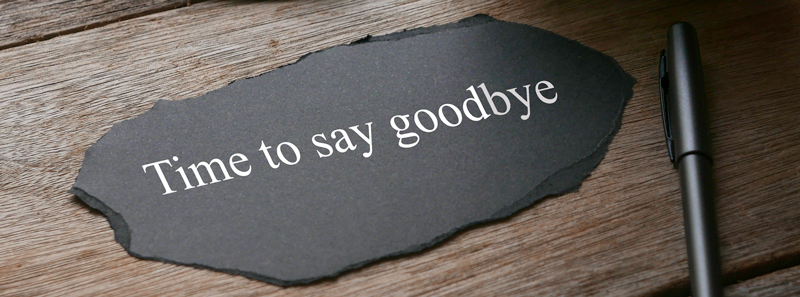 By Eric T. Cooperstein
By Eric T. Cooperstein
Read part one of Eric’s column: Figuring Out How and When to Withdraw from Representing a Client
After dealing with a very difficult client for many months, you have decided to withdraw. You have reviewed Rule 1.16 and believe that your withdrawal complies with that rule. The next step is to communicate your decision to the client.
How you do that is almost as important as the decision to withdraw itself. The client has (hopefully) paid you to represent them. You know their case. They believe you are “their” lawyer. There’s a good chance they will react emotionally to your decision to withdraw and express their disappointment, anger, disbelief, or frustration. They may file an ethics complaint.
A two-sentence e-mail is the wrong way to approach your departure. You have some ethical obligations to satisfy upon withdrawal that are better addressed deliberatively. A formal letter, either sent by e-mail as a PDF, or by U.S. mail or courier if the client is electronically challenged, is the way to go. I find clients are much more reactive to plain-text email communications. They start writing a response almost before they have finished reading the message. A letter, even as a PDF, tends to slow people down and allow them to think more.
Before you start drafting, take a deep, cleansing breath. You did not likely get to the point of withdrawing without being emotionally triggered by the client’s conduct. Sending an angry or spiteful letter will amp up the client. Remember that your letter could become an attachment to a future ethics complaint. In fact, you are designing a letter that will help any third parties who read it understand why you withdrew. A good withdrawal letter might make the difference between an investigation and a summary dismissal. So, channel your inner Vulcan and focus on the facts, not revenge.
Withdrawal situations are intensely fact driven. But there is a formula you can use for this letter:
1. Introduction
I see many draft withdrawal letters that start off in the middle of what happened that led to the withdrawal. Start at the beginning: “I am writing to notify you / confirm that I have decided to withdraw from representing you as of ______. This letter provides important information you may need to continue with your case.”
2. Facts
The client should receive some explanation of why you are withdrawing. If, for example, you are withdrawing because the client has not responded to your communications, it can be helpful to provide a chronology of your attempts to reach the client. If you have warned the client that you might withdraw, this is the place to remind the client of that fact. Be specific regarding the dates and forms of communications. If the number of events seems too long to chronicle, choose the most significant three to five items to cite. An exhaustive inventory of the client’s faults is not necessary. It is worth repeating, you want any third party who gets hold of this letter to be convinced that your withdrawal was appropriate—something any objectively reasonable lawyer would have done.
3. Timing
Move on to what will happen next. If you need to move to withdraw, state when the motion will be filed and when the hearing will be. If you only need to provide a notice to the court, either enclose a copy or state when you will file and serve the motion. Anticipate that the client may not have access to e-filing and service, requiring you to serve the client the old-fashioned way, with paper.
It may be that you are offering to perform one more task for the client, such as completing a reply memorandum or seeking a continuance on the client’s behalf. Be explicit about how long you are continuing to represent the client. Although a complete cessation of work for the client is preferred to make the end of the representation clear, if you decide to answer the client’s questions after your representation, set parameters on answering questions so that you cannot be accused later of establishing a new attorney-client relationship after the old one ended.
4. Deadlines
Remind the client of deadlines in their case, such as to respond to discovery, to submit exhibit lists, to file an appeal, etc. If a state-court complaint was just recently served but not filed, note the date by which the complaint must be filed with the court. Identify any applicable statute of limitations deadlines. State the obvious: “After I withdraw, I will not be taking any action to address these or any other issues in your case.”
5. Files
If you maintain the client’s file electronically, provide the file to the client by USB drive or a link to a file or folder they can download, even if the client hasn’t asked for the file. If you still have paper files, offer the client the opportunity to pick up a copy of the file after you have had time to create a copy for yourself. Your file should include your handwritten or computer notes of work on the case, your emails, and any invoices you sent the client. Very few items can be excluded; they are described in Rule 1.16(e).
Do not charge the client for the time you spend drafting and filing withdrawal documents or the time to photocopy the file. If you feel the urge to charge the client for the paper copies themselves, comply with the restrictions in Rules 1.16(f) and (g).
6. Fees
Figure out what you are planning to do if the client owes you money. If you are writing off a balance, let them know. If you will be filing an attorney lien on property involved in litigation or a later judgment, say so. If you intend to try to collect, this would be a good time to offer a discount in exchange for payment within a specified time period. Try not to overlook that if you want this client out of your life forever, chasing them for fees is not the way to go about reaching that goal.
If you owe the client a refund, send it. Do not forget that if you had a flat-fee retainer agreement with a client and you withdraw before all the work is complete, you will have to provide some refund to the client.
7. Good luck
Not to you, to the client! Seriously, wish the client well. When I have fired clients in my practice, it has usually been for a lack of cooperation or communication. They may be suffering from depression or some other illness. I try to get myself to a mental place where I can write that although I have made this decision, I am not angry at them and that I hope for the best for them. Your mileage may vary on that one. If you cannot stomach that, just express some hope that they are successful in obtaining their objective.
When you have finished the letter, if time permits, do not send it right away. That’s the emotional piece again. Come back to it a couple of hours later or the next day. You might also have a colleague review it for tone. With some planning and thoughtfulness, that letter may be your last contact with the client. You will be relieved when that letter goes out the door.
 Eric T. Cooperstein, the “Ethics Maven,” defends lawyers and judges against ethics complaints, provides lawyers with advice and expert opinions, and represents lawyers in fee disputes and law firm break-ups.
Eric T. Cooperstein, the “Ethics Maven,” defends lawyers and judges against ethics complaints, provides lawyers with advice and expert opinions, and represents lawyers in fee disputes and law firm break-ups.